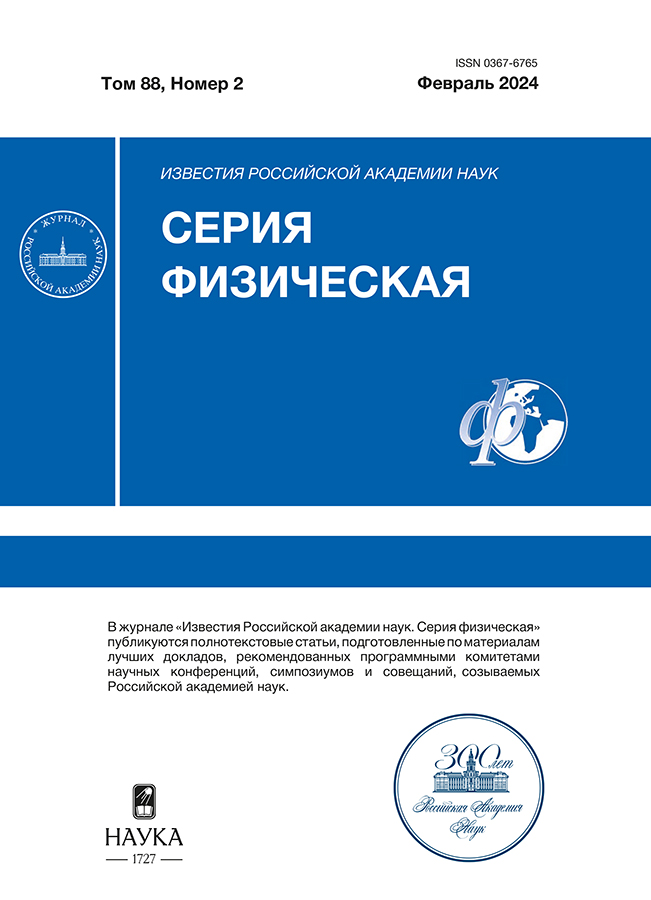Efficiency of sub-THz – DC energy conversion of a silicon detector
- Authors: Shchepetilnikov A.V.1, Khisameeva A.R.1, Fedotova Y.V.1, Dryomin A.A.1, Kukushkin I.V.1
-
Affiliations:
- Osipyan Institute of Solid-State Physics of the Russian Academy of Sciences
- Issue: Vol 88, No 2 (2024)
- Pages: 180-184
- Section: New Materials and Technologies for Security Systems
- URL: https://jdigitaldiagnostics.com/0367-6765/article/view/654746
- DOI: https://doi.org/10.31857/S0367676524020025
- EDN: https://elibrary.ru/RTWKBX
- ID: 654746
Cite item
Abstract
The efficiency of sub-THz to DC energy conversion of a silicon-based plasmonic detector was studied. The dependence of the signal at the detector output on the incident radiation power was measured. In the power linear region, the coefficient η was shown to grow with increasing power and to saturate in the sub-linear regime. The maximum achieved values of η were 0.4% for the radiation frequency of 97 GHz. The measurements were carried out both at room temperature and when the detector was cooled to liquid nitrogen temperature.
Full Text
About the authors
A. V. Shchepetilnikov
Osipyan Institute of Solid-State Physics of the Russian Academy of Sciences
Author for correspondence.
Email: shchepetilnikov@issp.ac.ru
Russian Federation, Chernogolovka
A. R. Khisameeva
Osipyan Institute of Solid-State Physics of the Russian Academy of Sciences
Email: shchepetilnikov@issp.ac.ru
Russian Federation, Chernogolovka
Ya. V. Fedotova
Osipyan Institute of Solid-State Physics of the Russian Academy of Sciences
Email: shchepetilnikov@issp.ac.ru
Russian Federation, Chernogolovka
A. A. Dryomin
Osipyan Institute of Solid-State Physics of the Russian Academy of Sciences
Email: shchepetilnikov@issp.ac.ru
Russian Federation, Chernogolovka
I. V. Kukushkin
Osipyan Institute of Solid-State Physics of the Russian Academy of Sciences
Email: shchepetilnikov@issp.ac.ru
Russian Federation, Chernogolovka
References
- Baydin A., Makihara T., Peraca N.M., Kono J. // Front. Optoelectron. 2021. V. 14. P. 110.
- Wang P.L., Lou J., Fang G.Y., Chang C. // IEEE Trans. Microw. Theory Techn. 2022. V. 70. No. 11. P. 5117.
- Pearson J.C., Drouin B.J., Yu S. // IEEE J. Microw. 2021. V. 1. No. 1. P. 43.
- Chen Z., Ma X., Zhang B. et al. // China Commun. 2019. V. 16. No. 2. P. 1.
- Yang X., Zhao X., Yang K. et al. // Trends Biotechnol. 2016. V. 34. No. 10. P. 810.
- Tzydynzhapov G., Gusikhin P., Muravev V. et al. // J. Infrared Millim. Terahertz Waves. 2020. V. 41. No. 6. P. 632.
- Shchepetilnikov A.V., Gusikhin P.A., Muravev V.M. et al. // Appl. Opt. 2021. V. 60. No. 33. P. 10448.
- Shinohara N. Recent wireless power transfer technologies via radio waves. Gistrup: River Publishers, 2018.
- Mizojiri S., Shimamura K. // IEEE Asia-Pacific Microwave Conference (APMC). (Singapore, 2019). P. 705.
- Citroni R., Di Paolo F., Livreri P. // Nanomaterials. 2022. V. 12. No. 14. P. 2479.
- Joseph S.D., Hsu Sh.H.S., Huang Y. // IEEE Int. Symp. Radio-Freq. Integr. Technol. (RFIT). 2021. P. 1.
- Muravev V.M., Gusikhin P.A., Andreev I.V., Kukushkin I.V. // Phys. Rev. Lett. 2015. V. 114. No. 10. Art. No. 106805.
- Muravev V.M., Gusikhin P.A., Zarezin A.M. et al. // Phys. Rev. B. 2019. V. 99. No. 24. Art. No. 241406.
- Muravev V.M., Kukushkin I.V. // Appl. Phys. Lett. 2012. V. 100. No. 8. Art. No. 082102.
- Муравьев В.М., Соловьев В.В., Фортунатов А.А. и др. // Письма в ЖЭТФ. 2016. Т. 103. № 12. С. 891.
- Shchepetilnikov A.V., Kaysin V.D., Gusikhin P.A. et al. // Opt. Quantum Electron. 2019. V. 51. No. 12. P. 1.
- Shchepetilnikov A.V., Kukushkin I.V., Muravev V.M. et al. // J. Infrared Millim. Terahertz Waves. 2020. V. 41. No. 6. P. 655.
- Хисамеева А.Р., Щепетильников А.И., Федотова Я.В. и др. // Изв. РАН. Сер. физ. 2023. Т. 87. № 2. С. 172; Khisameeva A.R., Shchepetilnikov A.V., Fedotova Ya.V. et al. // Bull. Russ. Acad. Sci. Phys. 2023. V. 87. No. 2. P. 145.
- Chiou H.K., Chen I.S. // IEEE Trans. Microw. Theory Techn. 2010. V. 58. No. 12. P. 3598.
- Weissman N., Jameson S., Socher E. W-band CMOS on-chip energy harvester and rectenna // IEEE MTT-S Int. Microwave Symp. (Tampa, 2014). P. 1.
- Kapilevich B., Shashkin V., Litvak B. et al. // IEEE Microwave. Wirel. Compon. Lett. 2016. V. 26. No. 8. P. 637.
- Shaulov E., Jameson S., Socher E. // IEEE MTT-S Int. Microwave Symp. (Honolulu, 2017). P. 307.
- He P., Zhao D.A. // IEEE MTT-S Int. Microwave. Symp. (Boston, 2019). P. 634.
- Wentzel A., Yacoub H., Johansen T.K. et al. // Proc. 17th EuMIC (Milan, 2022). P. 208.
Supplementary files












